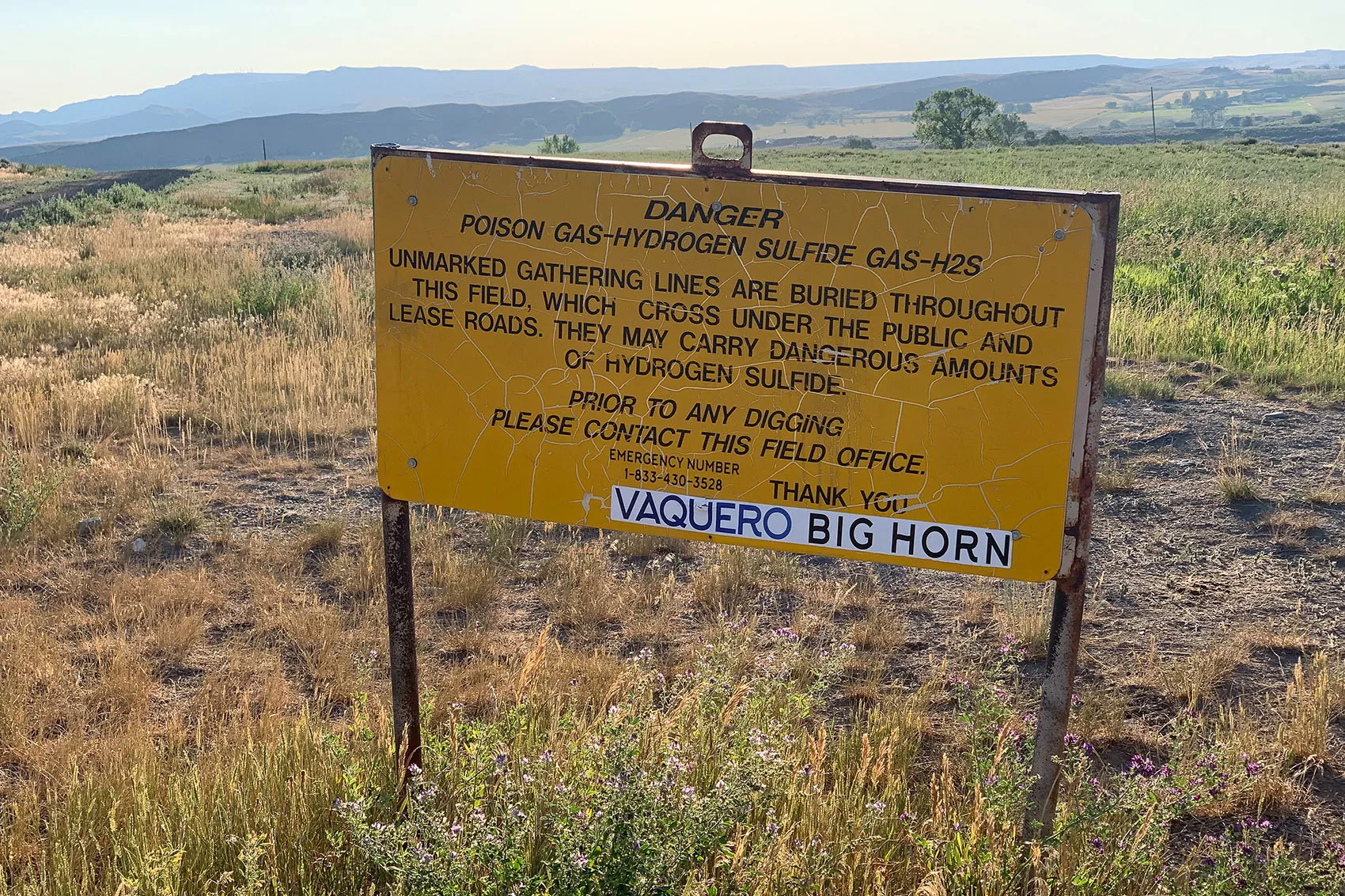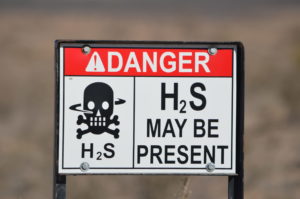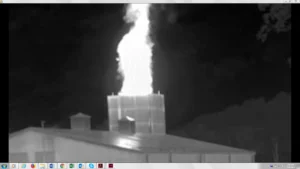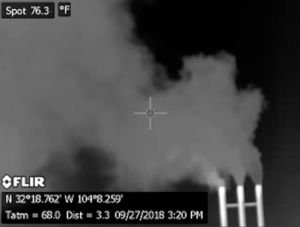Hydrogen sulfide gas is found in petroleum and natural gas. Oil or natural gas is considered sour if it has a high percentage of hydrogen sulfide. Natural gas can contain up to 28 percent hydrogen sulfide gas, consequently, it may be an air pollutant near petroleum refineries and in oil and gas extraction areas.
The principal source of anthropogenic hydrogen sulfide is as a by-product in the purification of natural gas and refinement of crude oil. Atmospheric releases of hydrogen sulfide represent the most significant public health concern for the geothermal energy industry.
Properties of Hydrogen Sulfide
Hydrogen sulfide gas is a naturally occurring chemical. The gas has a characteristic rotten egg odor at low concentrations. About half of the population can smell it at concentrations as low as 8 parts per billion (ppb) in air, and more than 90% can smell it at levels of 50 ppb. At higher concentrations, hydrogen sulfide rapidly deadens the sense of smell. For most people, this occurs at approximately 150 ppm.
Hydrogen sulfide is heavier than air, and it often settles in low-lying areas where it can accumulate in concentrations that can injure or kill livestock, wildlife, and human beings. Additionally, hydrogen sulfide has been found to migrate into surface soils and groundwater.
What is Sour Gas?
As mentioned above, oil or natural gas is considered sour if it has a high percentage of hydrogen sulfide. It has been estimated that 15 to 25% of natural gas in the U.S. may contain hydrogen sulfide. Worldwide, the percentage could be as high as 30%.
It has been reported, as well, that new drilling is increasingly being focused on deep gas formations that tend to be sour. Although the exact number of sour wells are not available, the EPA has reported that in the U.S. “the potential for routine H2S emissions [at oil and gas wells] is significant.”
Releases of hydrogen sulfide from sour gas wells or facilities may occur in a number of ways. U.S. EPA has collected documentation of sour gas well blowouts, line releases, extinguished flares, collection of sour gas in low-lying areas, and leakage from idle or abandoned wells that have impacted the public near oil and gas extraction sites. Other possible sources of hydrogen sulfide emissions at sour oil and gas operations are gas venting, and fugitive emissions (leaks) from well head equipment and compressors.
Environmental Concentrations of H2S
Typically, areas that are not exposed to industrial releases of hydrogen sulfide have airborne concentrations of less than 1 part per billion (ppb) hydrogen sulfide. Some non-industrial areas, however, do have higher ambient levels than 1 ppb, because hydrogen sulfide is a natural byproduct of decomposing organic matter than contains sulfur.
In areas with industrial sources of hydrogen sulfide, average concentrations of hydrogen sulfide in nearby neighborhoods may be present in the low parts per billion range, although maximum concentrations can be in the 100s of parts per billion range or higher (e.g., if there has been a large, industrial release). Also, spills, leaks, malfunctions or build-up of hydrogen sulfide in enclosed or low-lying areas can result in much higher, and sometimes lethal levels.
Examples of concentrations of hydrogen sulfide in communities with industrial activities:
- South Karelia, Finland: An air pollution study in the neighborhood of a pulp mill reported an average level of 3 ppb hydrogen sulfide, with a maximum 4-hour measurement of 40 ppb.
- In a neighborhood study near an oil refinery, peak measurements of 10 and 100 ppb were reported.
- Odessa, Texas: Residents living close to an industrial wastewater facility were exposed to levels ranging from 7-500 ppb. H2S air monitoring in oil and gas communities.
When oil and gas wells and facilities are situated near residential areas, there is the possibility that residents will be routinely exposed to hydrogen sulfide.
State agencies from across the United States receive hydrogen sulfide related complaints from citizens. In 2006, Lana Skrtic, a Masters degree student at the University of California at Berkeley, collected information on state studies conducted in response to hydrogen sulfide complaints related to oil and gas operations in Arkansas, Louisiana, New Mexico, and North Dakota. Download the Skrtic report. The table below summarizes the hydrogen sulfide concentrations measured in the four studies.
Briefly, these studies revealed that:
- hydrogen sulfide is present at or near oil and gas facilities, including oil and gas wells, tank batteries, gas processing plants, flares, compressor stations and refineries.
- levels of hydrogen sulfide ranged from the relatively low concentration of 2 ppb (recorded in Louisiana) to concentrations in the 1,000 ppb range (observed in New Mexico). Even the lowest average hydrogen sulfide concentration at these sites was higher than normal urban background levels, which are typically less than 1 ppb.
- As reported by Skrtic, “The levels measured in this study may be expected to produce a persistent odor, which has been shown in one study to have a negative effect on the mood of nearby residents.”
In August, 2005, Wilma Subra and the Oil and Gas Accountability Project spent five days in Monroe, Conecuh and Escambia counties in Alabama. The purpose of the visit was to measure concentrations of hydrogen sulfide and volatile organic compounds (VOCs) in the vicinity of known sources of air emissions, and to measure ambient concentrations of hydrogen sulfide and VOCs in residential neighborhoods. The goal of the project was not to identify facilities that have been breaking air quality laws, but rather, to determine if there is a potential air pollution problem that needs to be investigated and addressed in order to protect the health of the citizens in these Alabama counties.
As reported in the OGAP report, Air Sampling Conducted in Monroe, Conecuh and Escambia Counties, Alabama, hydrogen sulfide levels sampled in residential areas were measured at concentrations in the 100s and 1,000s of parts per billion. This is significantly elevated compared to normal urban background levels of less than 1 ppb, but comparable to other oil and gas regions in the U.S., where levels of hydrogen sulfide have been measured in the 100-15,000 ppb range in the vicinity of wells and facilities.
Based on the findings for both hydrogen sulfide and VOCs (which were in the parts per million range), it was recommended to the Alabama Department of Environmental Management that follow-up air monitoring occur both in residential and oil and gas production areas. The monitoring would help to hone-in on operations that may be emitting large quantities of hydrogen sulfide and VOCs, and evaluate whether the concentrations in residential neighborhoods are posing a threat to human health and the environment.
Health Effects from Hydrogen Sulfide Exposure
Common symptoms of exposure to long-term, low levels of hydrogen sulfide include headache, skin complications, respiratory and mucous membrane irritation, respiratory soft tissue damage and degeneration, confusion, impairment of verbal recall, memory loss, and prolonged reaction time. Exposure to high concentrations can cause unconsciousness, known as “knockdown,” and can be lethal.
The following information on health effects related to exposure to hydrogen sulfide was excerpted from Section 3.1.3 of the OGAP Report Air Sampling Conducted in Monroe, Conecuh and Escambia Counties, Alabama. Please download the report to find the references for the information below.
Exposure to hydrogen sulfide is one of the leading causes of sudden death in the workplace. At concentrations greater than 500 parts per million, inhalation of hydrogen sulfide can lead to immediate collapse and unconsciousness. A single breath at 1,000 ppm results in immediate loss of consciousness, cardiac arrest and death unless the unconscious victim is successfully revived. Unconsciousness and death have occurred in situations of prolonged exposure to hydrogen sulfide at concentrations of 50 ppm. Many occupational and community studies have documented the adverse health effects of exposure to relatively high levels of H2S.
Almost all organ systems are affected by hydrogen sulfide, but the most susceptible are those with exposed mucous membranes (e.g., eyes, noise and throat) and those with high oxygen demands (e.g., lungs, brain). Neurotoxicity of the central nervous system (causing nausea, dizziness, confusion, headaches and sleeping problems) and pulmonary edema (build-up of fluid in the lungs) are other well-documented effects of hydrogen sulfide poisoning. Cardiovascular and gastrointestinal toxicity are also associated with H2S exposure.
Research conducted by Kaye Kilburn, a medical doctor and professor of medicine at the University of Southern California, suggests that exposure to hydrogen sulfide may cause long-term, irreversible human health effects. Kilburn performed physiologic and psychological measurements on nineteen exposed individuals, and compared results with 202 unexposed subjects. Of the 19 exposed subjects, 10 were exposed at work sites, which included four oil and gas operations, and nine were exposed in their residences, which were near various sources of hydrogen sulfide. The concentrations to which the subjects were exposed are not known. Kilburn found that depression, anger, fatigue, tension, confusion and respiratory ailments were significantly higher in exposed subjects than the control group.
Increasingly, scientific research is revealing that even low concentrations of hydrogen sulfide (in the low parts per million or even the parts per billion range) can affect human health, especially when exposure occurs over an extended period of time. Some findings include:
- A study of hydrogen sulfide in the workplace found that workers complained of eye pain at a level of 6.4 ppm.
- Clinical studies suggest that short-term exposure to hydrogen sulfide at concentrations of 2 ppm may induce bronchial obstruction. In a study investigating the effects of hydrogen sulfide on asthmatics, two out of ten subjects exhibited a pronounced response when exposed to 2 ppm hydrogen sulfide. Airway resistance and conductivity were affected by more than 30%, suggesting significant bronchial obstruction.
- Former workers and residents living downwind of a crude oil processing plant had neurophysiological abnormalities. Residents in this study were exposed to hydrogen sulfide at 10 ppb, although concentrations occasionally reached 100 ppb.
- Residents near pulp and paper mills in Finland have reported an excess of health symptoms compared to residents living in a community without any industrial hydrogen sulfide sources. The annual mean concentrations of hydrogen sulfide in the affected community was 8 µg/m3 (5.7 ppb). Symptoms included respiratory, eye and nasal problems). Residents in the pulp and paper community were also exposed to other sulfur compounds, but hydrogen sulfide accounted for more than two-thirds of the sulfur compounds monitored in the community.
- Symptoms of adverse health effects experienced by residents in Odessa, TX and Puna, Hawaii, two communities with industrial sources of hydrogen sulfide were compared to the same symptoms in three communities without industrial sources of hydrogen sulfide. The residents in Odessa were exposed to hydrogen sulfide concentrations of 7-27 ppb (annual average), with maximum 8-hour measurements between 335 and 503 ppb. Exposure in Puna is less clear, but some data from the 1990s indicate hourly averages in the low-ppb range, with most below 1 ppb. Between June 1996 and 1997, peak hydrogen sulfide concentrations was 301.7 ppb. In other years, releases of hydrogen sulfide between 200-500 ppb were reported. The two hydrogen sulfide-exposed communities were similar with respect to the adverse health effects (e.g., central nervous systems, ear/nose/throat, respiratory, muscle/bone, skin, immune, cardiovascular, digestive, teeth/gums, urinary, blood) reported by residents. Percentages of affected residents in the hydrogen sulfide-exposed communities were statistically different (higher) than the non-exposed communities.
Hydrogen Sulfide Regulations
There are no international health-based standards for hydrogen sulfide. The World Health Organization (WHO) has an air quality guideline of 150 µg/m3 (10.6 ppb) hydrogen sulfide, averaged over a 24-hour period. This guideline is based on the avoidance of eye irritation. Also, WHO recommends that hydrogen sulfide concentrations not exceed 0.005 ppm (5 ppb; 7 µg/m3), over a 30-minute period, to avoid substantial complaints about odor.
Within the United States, there is no federal ambient air quality standard for hydrogen sulfide, but more than 30 states have chosen to independently regulate hydrogen sulfide levels to protect the public from adverse effects related to hydrogen sulfide exposure. Some states have standards based on short-term hydrogen sulfide levels (averaged over 15 minutes), while others use an average over a much longer period of time (extending up to one-year). The table, below, includes information for states that have ambient air quality standards (or guidelines) for hydrogen sulfide.
The most stringent one-hour standard—found in New Mexico, New York and Kentucky—is 10 parts per billion (ppb). In other words, those states believe there will be some effect on citizens exposed to hydrogen sulfide at a level of 10 ppb for at least one hour. The effects may be health-related or the odors may create a nuisance for the citizens.
At least twelve states have standards for hydrogen sulfide measured over a 24-hour period. These levels are lower than the 1-hour limits, and vary from concentrations of 0.65 ppb (Massachusetts) to 200 ppb (Oklahoma).







